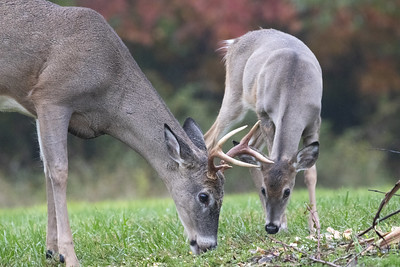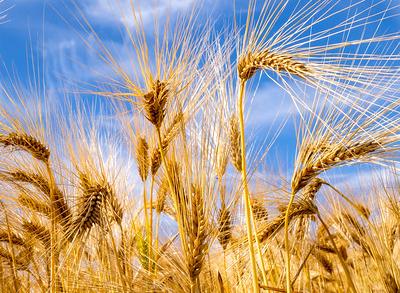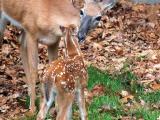When Christopher Johnson, PhD, set out to study whether lab mice fed prion-contaminated plants developed neurodegenerative disease, he expected the plants to take up only small prion clusters, but they absorbed large clusters characteristic of prion diseases in deer and other animals.
Then again, "Prions are constantly surprising," Johnson, a study coauthor and deputy director of the Office of Science Quality and Integrity at the US Geological Survey in Reston, Virginia, told CIDRAP News. "But perhaps we shouldn't ever be allowed to be surprised by them, because they are so resistant to degradation, and they are so resilient that finding prions in unusual settings is maybe something that we should all begin to just expect."
Prions are infectious misfolded proteins that cause fatal neurodegenerative diseases such as chronic wasting disease (CWD) in cervids like deer and elk, scrapie in sheep and goats, bovine spongiform encephalopathy (BSE, or "mad cow" disease) in cattle, and Creutzfeldt-Jakob disease in humans.
In the case of CWD, once an animal is infected, it can spread the disease through direct contact, saliva, antler velvet, urine, feces, and carcasses, and the prions can persist in the environment for years. Once an animal is exposed, the incubation period in a host—the time before symptoms appear—is thought to be up to 2 years.
But given the rapid spread of CWD throughout North America and parts of Europe and Asia, scientists question whether it is also being transmitted through a different route, such as the ingestion of contaminated plants.
Prions remain infectious in plants
While researchers have been experimenting with protein uptake into plants since the 1970s, Johnson and colleagues' laboratory study, published in iScience in December, takes those investigations a step further. They demonstrated that alfalfa, barley, and Arabidopsis thaliana, a small plant from the mustard family called thale cress and other names, all accumulated sufficient prions from contaminated soil in their above-ground tissues to cause mice that ingested the plant tissues to develop prion disease.
"There was a previous study that looked to see if plants could become surface-contaminated or potentially accumulate prions at all, and it looked like they could," Johnson said. "Our study shows that, under these lab conditions, consumption of contaminated plants could cause an infection," with implications for wildlife conservation, agriculture, and public health.
The lead author of the previous study, Sandra Pritzkow, PhD, associate professor of neurology at McGovern Medical School at UTHealth Houston, said that prions can't replicate, or reproduce, in plants, so plants, like earthworms, should be considered potential carriers rather than hosts.
Published in Cell Reports in 2015, Pritzkow's lab study showed that prions diluted in brain, urine, or feces can bind to and be taken up by wheat-grass roots and leaves. They also showed that wild-type hamsters that ate contaminated grass incubated in infected brain material were subsequently infected, which the authors said suggests "a possible role of environmental prion contamination in the horizontal transmission of the disease."

Finding that plants can accumulate prions from contaminated soil to biologically relevant levels in the above-ground tissues—at least in the lab—is concerning, Johnson said: "Plants are obviously moved in the case of agriculture across the continents, the world, and so you know that brings up the concern that these plants may be able to take prions to new places or expose animals or humans when they're in a place where perhaps chronic wasting disease isn't thought to occur."
Stuart Lichtenberg, PhD, director of environmental chemistry at the Minnesota Center for Prion Research and Outreach (MNPRO) and a working group member on CIDRAP's CWD contingency-planning project at the University of Minnesota, pointed out that, given prion behavior, the likelihood of eliminating prion infectively in crops is low.
If cultivated crops were to take up sufficient amounts of prions to be infectious, "Those prions would remain infectious for as long as that foodstuff or feed or what have you was stored," he said. "If a farmer was growing a field of alfalfa and used that as a forage for his animals, stored for a season or two, even after cutting that grass, alfalfa, hay, it's still going to be infected with prions when it's fed to animals."
And remediation of prion uptake in crops is a relatively unexplored area. High concentrations of chemicals such as bleach, for example, can work if you can zero in on a hot spot, Lichtenberg said, "but obviously there are issues with spraying a whole lot of bleach on, say, a cornfield."
Norway moves to prevent import of contaminated plants
The possibility of importing contaminated plants prompted Norway in 2018 to ban the import of hay and straw for animal feed from CWD-positive areas outside the European Economic Area.
The regulation specifies that hay and straw must be accompanied by manufacturer confirmation that the product has been stored for at least 2 months and that it wasn't harvested from a farm that used animal manure fertilizer in the past 2 years, as well as a regulatory veterinarian attestation that the product doesn't come from a CWD-positive area.
Kristin Ruud Alvseike, a veterinarian at the Norwegian Food Safety Authority, said the main concern behind the ban was the spread of CWD from North America to cervids in Norway rather than to non-cervid animals and humans.
"Our goal is to confine the disease, or, if possible, eradicate it," she said. "The regulation of hay and straw is one of many elements we have implemented in this matter."
She added that the epidemiologic situation in Norway is very different from the one in the United States. "Our first case was detected in 2016; since then we have detected 21 cases of contagious CWD, all of them in wild reindeer," she said. "The last case was in 2022. This indicates that we are in an early phase of the disease."
No evidence that prions in plants infect deer
But while it may be possible for deer or non-cervid animals such as people to be exposed to prions in contaminated plants, there has been no evidence of infection, and the CWD-prion species barrier, which prevents zoonotic transmission, is thought to be high in humans.





















